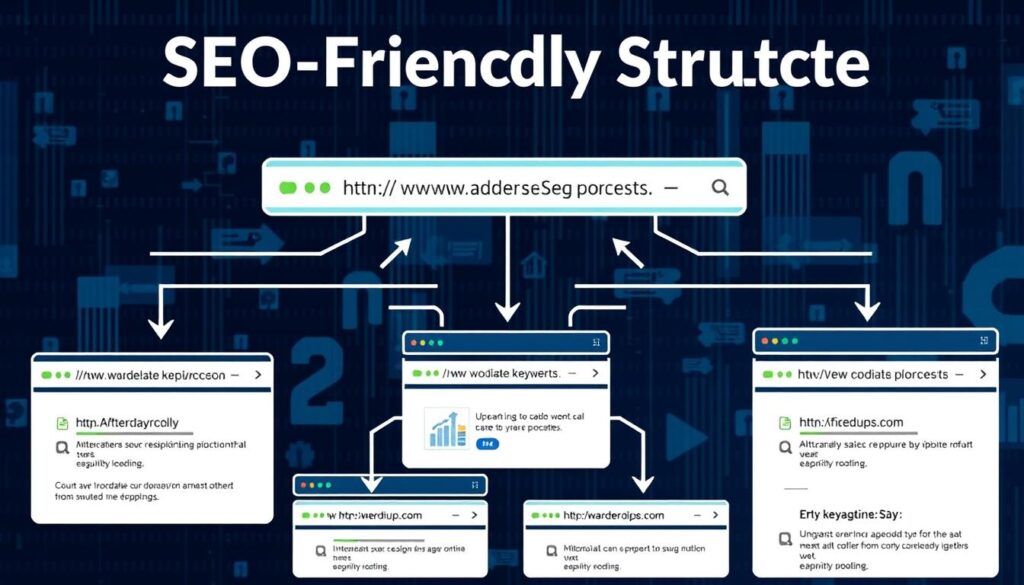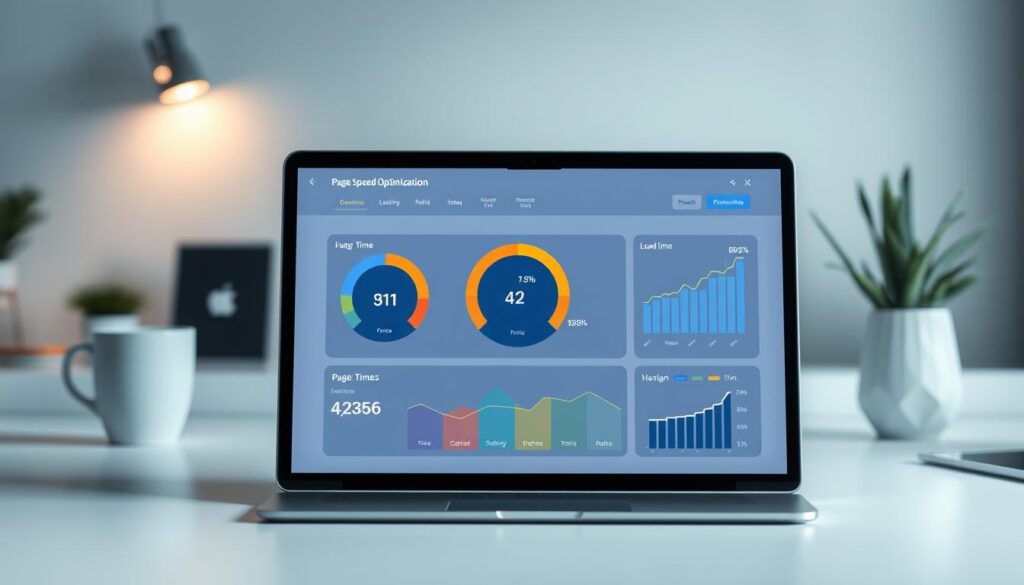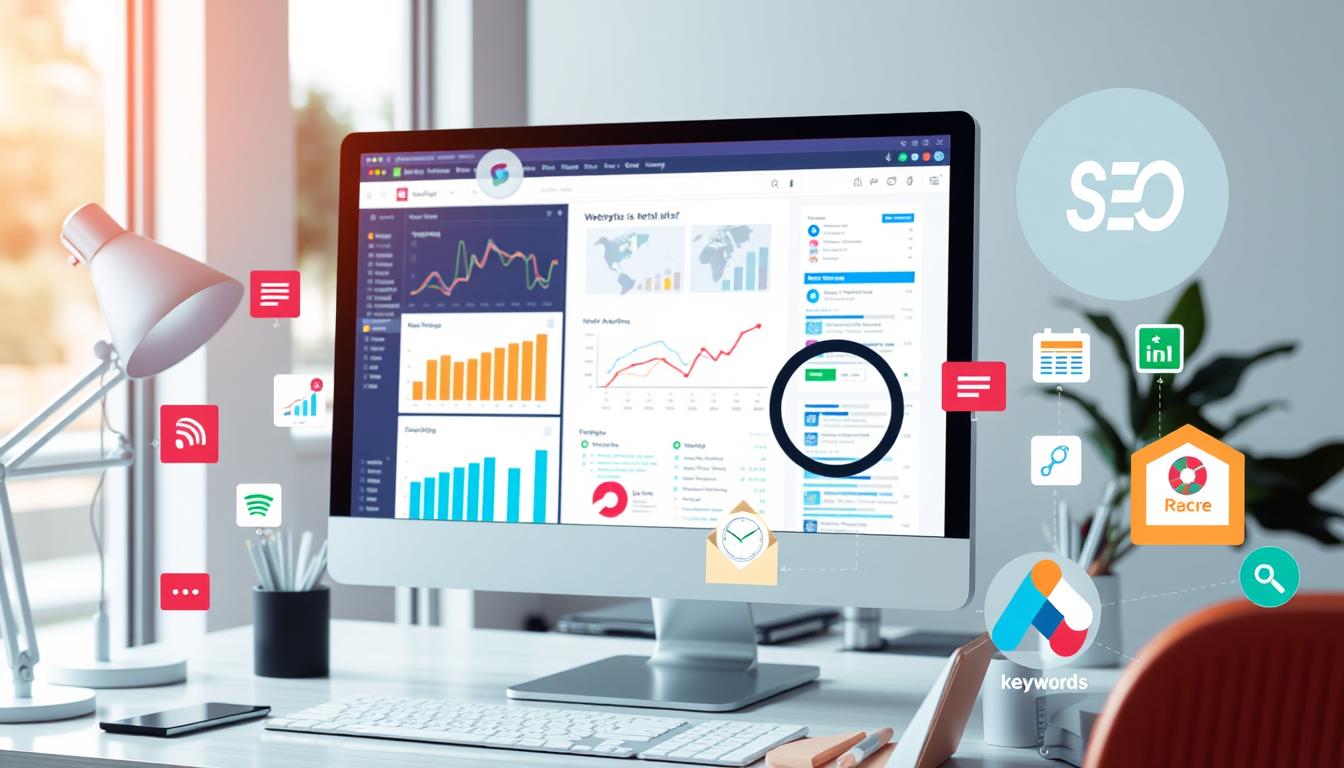In the dynamic realm of search engine optimization (SEO), a pivotal element emerges as the cornerstone for unlocking your website’s full potential: on-page optimization. Ever pondered, What secret techniques do the most successful websites employ to dominate search engine results? This exhaustive guide will reveal the critical strategies that can elevate your website to the pinnacle of search engine rankings. It will drive organic traffic and grant your brand unmatched visibility.
Key Takeaways
- Discover the core elements of on-page SEO and their impact on search engine rankings.
- Understand how search engine algorithms work and the role of user experience in determining your website’s visibility.
- Leverage powerful keyword research techniques to identify the most lucrative opportunities for your business.
- Craft captivating title tags and meta descriptions that entice clicks and boost your click-through rate (CTR).
- Optimize your content, images, and URL structure to maximize the relevance and authority of your web pages.
What is On-Page Optimization?
In the realm of search engine optimization (SEO), on-page optimization emerges as a pivotal factor for enhancing a website’s visibility and ranking. This endeavor entails refining various aspects of individual web pages to elevate their relevance and allure for both search engines and users.
Definition and Importance
On-page optimization encompasses the art of refining a web page’s content, structure, and HTML elements to bolster its ranking potential in search engine results. Its significance cannot be overstated, as search engines rely on these on-page to gauge the webpage’s relevance and quality, thereby influencing its overall ranking and visibility.
Key Elements of On-Page SEO
The core components of on-page optimization include:
- Content optimization, which entails crafting high-quality, pertinent, and captivating content that aligns with the user’s search intent.
- Keyword optimization, where target keywords are strategically woven into the page’s content, titles, and metadata.
- HTML structure optimization, encompassing the utilization of header tags (H1, H2, H3), meta tags, and other technical elements that signal the page’s structure and relevance to search engines.
- Image optimization, which involves optimizing images with appropriate file names, alt text, and compression to enhance page speed and user experience.
- URL optimization, where the page’s URL structure is crafted to be more search-engine friendly and descriptive.
By concentrating on these on-page optimization facets, website proprietors and content creators can significantly enhance the overall content optimization and SEO elements of their webpages. This, in turn, improves their prospects of achieving higher rankings in search engine results and attracts more targeted traffic to their site.
Understanding Search Engine Algorithms
To excel in search engine optimization (SEO), a deep understanding of search engine algorithms is paramount. These intricate algorithms dictate the rankings of web pages. By comprehending their mechanisms, you can craft content that meets their criteria, ensuring an outstanding user experience.
How Search Engines Rank Pages
Google and other search engines utilize advanced algorithms to assess and rank web pages. These ranking factors encompass content quality and relevance, website structure, user intent, and site performance.
The Role of User Experience
- Search engines prioritize user experience, striving to deliver the most pertinent and fulfilling results.
- Elements such as page speed, mobile-friendliness, and site responsiveness are pivotal in determining rankings.
- Optimizing your site for a seamless user experience enhances search engine rankings and audience engagement.
Grasping the complexities of search engine algorithms and the significance of user experience is crucial for a successful on-page SEO strategy. By aligning your content and website structure with these elements, you can elevate your pages’ visibility and engagement with your target audience.
Keyword Research for On-Page Optimization
Effective keyword research serves as the cornerstone of successful on-page optimization. It entails the identification of the most pertinent and efficacious target keywords that your audience actively seeks. By grasping the specific terms and phrases users input into search engines, you can craft content that aligns with their needs, thereby enhancing your website’s visibility.
Identifying Target Keywords
The initial phase of keyword research necessitates the generation of a list of potential target keywords pertinent to your enterprise, offerings, or services. Reflect on the inquiries your clientele frequently pose, the challenges they aim to overcome, and the subjects they find intriguing. Such contemplation can unveil the most advantageous keywords to pursue.
Tools for Keyword Research
Various tools are at your disposal to aid in keyword research, including Google Keyword Planner, SEMrush, and Ahrefs. These instruments offer indispensable insights into search volume, competition, and ancillary keywords, thereby guiding your on-page optimization strategy.
Long-Tail vs. Short-Tail Keywords
In the realm of keyword research, discerning between long-tail keywords and short-tail keywords is crucial. Long-tail keywords, characterized by their specificity, typically encompass three or more words, and often exhibit lower search volumes but superior conversion rates. Conversely, short-tail keywords, being more generic, boast higher search volumes but face stiffer competition. Adopting a strategy that harmoniously integrates both long-tail and short-tail keywords can effectively cater to your target audience.
Crafting Effective Title Tags
In the realm of on-page SEO, the significance of your title tags cannot be overstated. These concise text snippets serve as the initial impression for users in search engine results and browser tabs. Achieving a balance between SEO best practices and strategic branding is essential for crafting effective title tags.
Best Practices for Title Tags
To optimize your title tags for search, adhere to these guidelines:
- Ensure the length falls within 50-60 characters for optimal display in search results.
- Position your target keywords near the beginning of the tag.
- Avoid keyword stuffing, aiming for a natural, readable title instead.
- Make each page distinct by using unique title tags.
Importance of Branding in Title Tags
Title tags must be SEO-friendly but also serve as a platform to showcase your brand. By incorporating your company name or a recognizable tagline, you can boost brand awareness. This increases the likelihood of users clicking through to your site.
The ideal title tag harmonizes SEO best practices with your brand’s unique identity. It entices users to explore your content, making it a pivotal element in your SEO strategy.
Writing Compelling Meta Descriptions
In the realm of search engine optimization (SEO), meta descriptions are pivotal in capturing the interest of potential website visitors. These concise summaries, appearing below the page title in search engine results, significantly impact click-through rates. They also aid search engines in comprehending your page’s content.
Techniques for Engaging Meta Descriptions
Creating engaging meta descriptions necessitates a combination of creativity and strategic planning. Several effective techniques are worth considering:
- Emphasize the primary benefits or unique selling points of your page’s content.
- Employ action-oriented language to prompt users to visit your site.
- Integrate relevant keywords while ensuring the description remains readable.
- Personalize the message to directly address your target audience.
- Strive for a conversational tone that connects with your readers.
Meta Description Length Guidelines
Regarding meta description length, search engines generally advise keeping it within 150-160 characters. This ensures the full description is visible in search results without truncation. Nonetheless, it’s crucial to acknowledge that character limits can differ across various search engines. Therefore, it’s advisable to continually test and refine your meta descriptions.
By excelling in the craft of writing compelling meta descriptions, you can significantly boost your website’s visibility. This, in turn, drives more traffic and enhances your overall SEO performance.
Utilizing Header Tags (H1, H2, H3)
In the realm of on-page optimization, the strategic deployment of header tags, including H1, H2, and H3, is paramount. These elements are instrumental in organizing your content and boosting its search engine visibility. They enable search engines to discern the hierarchy and significance of various sections on your web pages. This, in turn, refines the overall content structure and SEO hierarchy.
Understanding the Hierarchy of Header Tags
The hierarchy of header tags is a strict sequence, with H1 holding the highest precedence and H3 the lowest. Adherence to this order is essential:
- H1: This is the primary title or headline of your page, necessitating uniqueness and a precise reflection of the overarching topic.
- H2: These are the principal section headings, dividing your content into coherent and easily navigable segments.
- H3: These are the subheadings within each H2 section, offering further detail and structure to your content.
Best Practices for Header Tags
To optimize the effectiveness of your header tags, consider these guidelines:
- Adhere to the correct hierarchy (H1, H2, H3) to foster a well-organized and logical content structure.
- Integrate your target keywords naturally within your header tags to enhance SEO hierarchy.
- Ensure your header tags are concise, informative, and captivating to engage the reader’s interest.
- Avoid excessive use of H1 tags, as each page should only feature one H1 tag.
- Verify that the content within each header tag is pertinent and supports the overarching topic.
By following these guidelines, you can harness the full potential of header tags to improve the structure and search engine optimization of your web pages.
Optimizing Content for SEO
In the domain of on-page SEO, the essence of your content’s quality and optimization cannot be overstated. The creation of valuable, meticulously structured content that meets your audience’s needs is fundamental to enhancing your website’s search engine visibility and performance.
Importance of Quality Content
Quality content stands as a cornerstone in the realm of successful content optimization. Search engines prioritize websites that offer informative, engaging, and user-centric content. By producing content that is both relevant and valuable, you can elevate your website’s credibility, boost user engagement, and, consequently, improve your search engine rankings.
Content Length and Keyword Density
The length of your content and the strategic deployment of keywords are pivotal in content optimization. Strive for an optimal content length that allows for a comprehensive exploration of the topic, while ensuring a natural flow and readability. Furthermore, maintain an appropriate keyword density, ensuring that your target keywords and LSI keywords are seamlessly integrated throughout the text without compromising the overall quality and user experience.
Using LSI Keywords
- Incorporate LSI (Latent Semantic Indexing) keywords to enhance the relevance and context of your content.
- LSI keywords are semantically related terms that search engines use to better understand the overall topic and meaning of your content.
- By including relevant LSI keywords, you can improve the content optimization and increase the chances of your content appearing in search results for related queries.
Optimizing your content for search engines is a critical aspect of on-page SEO. By focusing on quality, content length, keyword density, and the strategic use of LSI keywords, you can create content that not only resonates with your audience but also aligns with search engine algorithms, ultimately improving your website’s keyword density and overall online visibility.
Image Optimization Techniques
Optimizing your images is a critical component of on-page SEO. It ensures your visual content loads swiftly and aids search engines in comprehending your images’ context. Focus on two essential techniques: image optimization and file compression.
Importance of Alt Text
Alt text, or alternative text, offers a descriptive tag for images. It is displayed when an image fails to load and aids search engines in grasping your visuals’ content. Crafting alt text that is informative and rich in keywords is pivotal for optimizing your images.
File Naming and Compression
File naming and compression are also vital for image optimization. Opt for descriptive, keyword-rich file names over generic ones like “IMG_123.jpg.” Additionally, compress your images using suitable formats and tools to ensure rapid loading without compromising quality.
Employing these image optimization strategies can elevate your visual content’s visibility and performance. This, in turn, enhances user experience and contributes to better search engine rankings.
Improving URL Structure

Optimizing URL structure is paramount in on-page optimization. Well-crafted URLs not only elevate user experience but also significantly contribute to search engine optimization (SEO). Adhering to best practices for SEO-friendly URLs can enhance your web pages’ visibility and ranking.
Best Practices for SEO-Friendly URLs
To forge SEO-friendly URLs, adhere to these guidelines:
- Integrate keywords that precisely encapsulate the page’s content. This facilitates search engines’ comprehension of your page’s relevance, thereby boosting ranking potential.
- Ensure the URL is concise and descriptive. Refrain from incorporating superfluous words or parameters, which can elongate the URL and diminish user-friendliness.
- Employ lowercase letters and hyphens to demarcate words in the URL. Eschew spaces, underscores, or special characters, as they can impede URL structure and SEO efficacy.
- Align the URL structure with your website’s content hierarchy. This facilitates search engines’ comprehension of your pages’ interconnectivity.
- Periodically assess and refine your existing URLs to ensure congruence with your prevailing keyword optimization strategy.
The Role of Keywords in URLs
Incorporating pertinent keywords into your URLs is essential for SEO. Keywords within the URL convey to search engines the page’s topical relevance and focus. This can lead to enhanced rankings and increased click-through rates from search results.
When embedding keywords in your URLs, aim for a balance between relevance and legibility. Avoid keyword stuffing or excessive keyword usage, as it can harm user experience and may be perceived as spam by search engines.
By adhering to these URL structure best practices and integrating relevant keywords, you can significantly enhance your web pages’ SEO-friendliness. This, in turn, drives more targeted traffic and amplifies your online presence.
Internal and External Linking Strategies
Effective linking strategies are pivotal in optimizing your website for search engines and enhancing user experience. Implementing a well-thought-out internal and external linking approach can significantly improve site structure. It guides visitors through your content and establishes your website’s credibility.
Benefits of Internal Linking
Internal linking, the practice of connecting your web pages through hyperlinks, offers several benefits for your on-page internal linking strategy:
- Distributes page authority and ranking signals throughout your website, helping strengthen the overall site structure.
- Improves user navigation and helps visitors discover relevant content, leading to increased engagement and decreased bounce rates.
- Establishes a clear hierarchy and information architecture, making it easier for search engines to understand the relationships between your pages.
How to Choose External Links
Selecting the right external external linking partners is crucial for building link building authority and credibility. When choosing external links, consider the following best practices:
- Relevance: Link to high-quality, authoritative websites that are relevant to your niche and provide additional value to your readers.
- Trustworthiness: Prioritize external links from reputable, well-established sources that have a strong online presence and positive reputation.
- Diversity: Diversify your external links, linking to a variety of relevant websites rather than relying on a single source.
By strategically implementing internal and external linking, you can improve the overall structure, user experience, and search engine optimization of your website. This ultimately drives more traffic and enhances your online visibility.
Mobile-Friendliness and Responsive Design
In today’s digital realm, where mobile devices reign supreme, the significance of mobile optimization is paramount. As an increasing number of users navigate websites and web applications via smartphones and tablets, it becomes imperative for businesses to ensure their online presence is both mobile-friendly and responsive. This adaptation is critical for maintaining relevance in a mobile-centric world.
Importance of Mobile Optimization
The exponential rise in mobile internet usage has rendered a mobile-friendly website indispensable, rather than a mere luxury. By optimizing your website for mobile devices, you guarantee that your content is not only accessible but also user-friendly. This, in turn, fosters improved engagement, enhances conversion rates, and elevates overall user satisfaction.
Tools for Testing Mobile Responsiveness
- Google’s Mobile-Friendly Test – This free tool from Google analyzes your website’s mobile-friendliness and provides valuable insights on how to improve your site’s performance on mobile devices.
- Responsive Design Checklist – Use this comprehensive checklist to ensure your website meets the best practices for responsive design, including layout, navigation, and content optimization.
- BrowserStack – This platform allows you to test your website across multiple devices and browsers, ensuring your site looks and functions correctly on a wide range of mobile devices.
By adopting a mobile-first approach and utilizing the appropriate tools for testing and optimization, businesses can ensure their websites are not only mobile-friendly but also deliver an exceptional user experience across all devices. This not only increases customer satisfaction but also positively impacts your search engine rankings, as mobile optimization and responsive design are pivotal for mobile-friendly websites.
Page Speed Optimization

In today’s fast-paced digital landscape, page speed has become a crucial factor in delivering a seamless user experience. Websites with fast-loading pages not only enhance customer satisfaction but also boost their search engine optimization (SEO) efforts. By optimizing page speed, you can improve your site’s performance and ensure your content reaches your audience effectively.
Factors Affecting Page Speed
Several elements can impact the page speed and site speed of your website. These include, but are not limited to:
- Image optimization: Optimizing image file sizes, formats, and compression can significantly reduce page load times.
- Code minification: Minimizing the size of your HTML, CSS, and JavaScript files can improve performance optimization.
- Browser caching: Leveraging browser caching can ensure that returning visitors load your pages faster by reducing the need to re-download resources.
- Server response time: Ensuring your web server can handle the incoming traffic and respond quickly is crucial for maintaining fast page loads.
Tools to Measure Page Speed
Fortunately, there are various tools available to help you measure and analyze the page speed of your website. One of the most popular and widely-used tools is Google PageSpeed Insights, which provides detailed insights into the performance of your pages and offers recommendations for improvement.
By utilizing these tools and addressing the identified performance issues, you can optimize your website’s page speed and site speed, ultimately enhancing the overall user experience and boosting your search engine rankings.
Tracking On-Page SEO Success
Monitoring your on-page SEO efforts is essential for pinpointing areas needing improvement and ensuring your website’s search engine visibility. By closely tracking key performance metrics, you can assess the efficacy of your optimization strategies. This allows for data-driven decisions to bolster your overall online presence.
Metrics to Monitor
Regularly monitor your website’s organic traffic, bounce rate, and conversion rates to gauge the success of your on-page SEO initiatives. Organic traffic reflects the number of visitors arriving at your site through search engine queries. Conversely, bounce rate indicates how many users quickly leave without engaging further. Conversions, such as lead generation or product sales, demonstrate the impact of your optimized content on user actions.
Tools for Analyzing Performance
Leverage industry-leading analytics platforms, such as Google Analytics and Google Search Console, to gain valuable insights into your website’s performance. These tools provide comprehensive data on user behavior, search engine visibility, and technical SEO factors. They empower you to identify strengths, weaknesses, and opportunities for improvement in your on-page optimization efforts.

